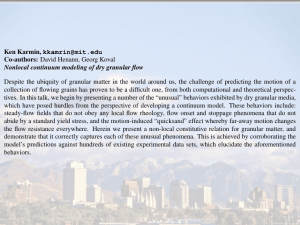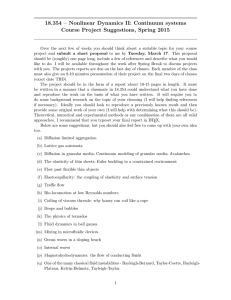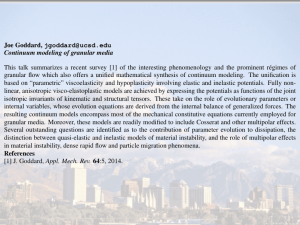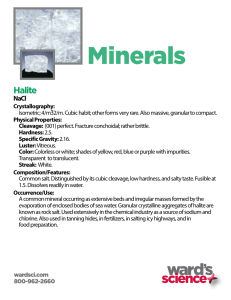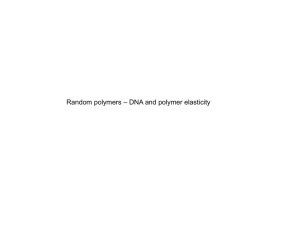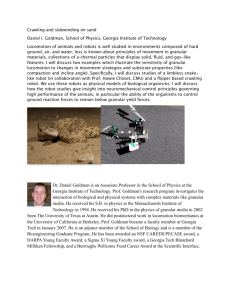Structure and dynamics of vibrated granular chains: Comparison to equilibrium polymers
advertisement
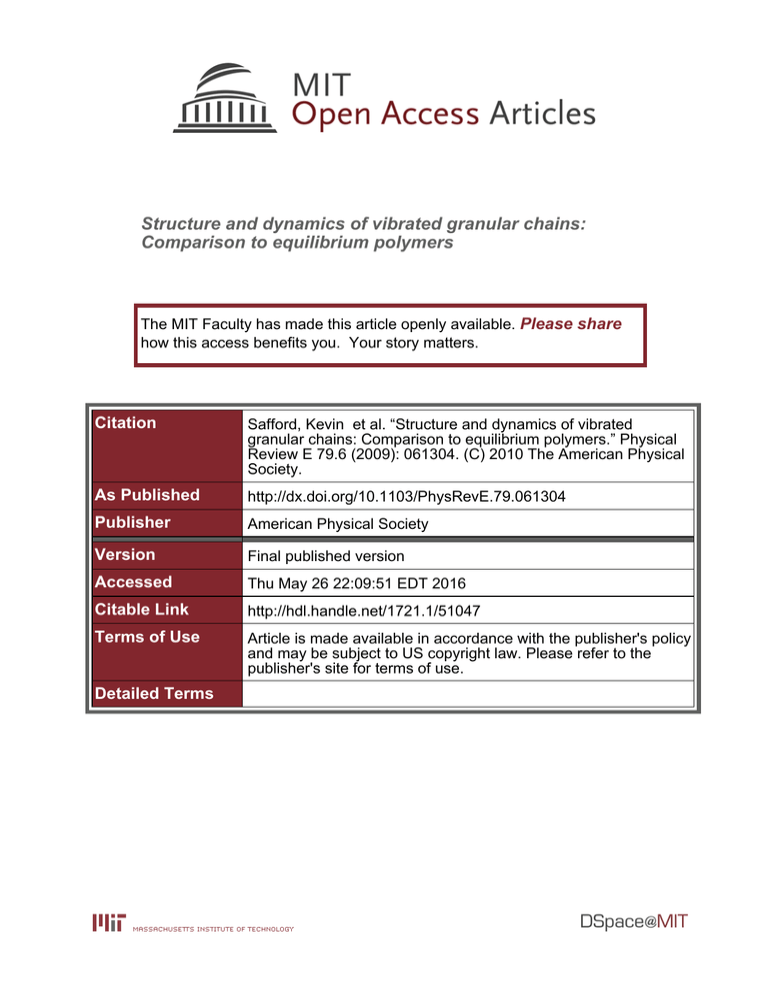
Structure and dynamics of vibrated granular chains: Comparison to equilibrium polymers The MIT Faculty has made this article openly available. Please share how this access benefits you. Your story matters. Citation Safford, Kevin et al. “Structure and dynamics of vibrated granular chains: Comparison to equilibrium polymers.” Physical Review E 79.6 (2009): 061304. (C) 2010 The American Physical Society. As Published http://dx.doi.org/10.1103/PhysRevE.79.061304 Publisher American Physical Society Version Final published version Accessed Thu May 26 22:09:51 EDT 2016 Citable Link http://hdl.handle.net/1721.1/51047 Terms of Use Article is made available in accordance with the publisher's policy and may be subject to US copyright law. Please refer to the publisher's site for terms of use. Detailed Terms PHYSICAL REVIEW E 79, 061304 共2009兲 Structure and dynamics of vibrated granular chains: Comparison to equilibrium polymers 1 Kevin Safford,1 Yacov Kantor,2 Mehran Kardar,3 and Arshad Kudrolli1 Department of Physics, Clark University, Worcester, Massachusetts 01610, USA Raymond and Beverly Sackler School of Physics and Astronomy, Tel Aviv University, Tel Aviv 69978, Israel 3 Department of Physics, Massachusetts Institute of Technology, Cambridge, Massachusetts 02139, USA 共Received 16 January 2009; published 10 June 2009兲 2 We show that the statistical properties of a vibrated granular bead chain are similar to standard models of polymers in equilibrium. Granular chains of length up to N = 1024 beads were confined within a circular vibrating bed, and their configurations were imaged. To differentiate the effects of persistence and confinement on the chain, we compared with simulations of both persistent random-walk 共RW兲 and self-avoiding walk 共SAW兲 models. Static properties, such as the radius of gyration and structure factor, are governed for short chains 共N ⱕ 128兲 by persistence and can be matched by those of RWs. Self-avoidance and confinement effects are both important for longer chains and the results are well described by equilibrated SAWs. We also find that the collective dynamics of the granular chain is similar to the Rouse model of polymers. In particular, as long as confinement is negligible, the center of mass of the chain diffuses with a diffusion coefficient that scales as 1 / N, and the dynamic structure factor decays exponentially in time. DOI: 10.1103/PhysRevE.79.061304 PACS number共s兲: 81.05.Rm, 05.40.⫺a, 82.35.Lr, 05.70.Jk I. INTRODUCTION A question of fundamental interest is the extent to which equilibrium statistical physics and entropic considerations apply to excited granular matter 关1–4兴. Because of the dissipative nature of the collisions, energy has to be constantly supplied in order to keep granular matter moving. It is plausible that under sufficiently random driving and over long enough times, a granular system will explore most of the available configurational space, such that its properties can be described by equilibrium statistics. Indeed, Edwards 关2兴 proposed a generalized statistical mechanical approach where thermodynamic quantities are calculated from averages over grain configurations, but this approach has not been rigorously established. An appealing system to explore this connection is a granular chain excited by a vibrated rough substrate, where the corresponding equilibrium model for polymers is well developed 关5–7兴. A vibrated bed is used widely in industry to transport and sort granular matter and is a convenient method to obtain a driven out-of-equilibrium steady state 关8–10兴. Equilibriumlike properties have been observed with spherical particles with such vibrated systems 关11兴. Granular chains consisting of beads connected with flexible links were introduced by Ben-Naim and co-workers 关12–14兴 to study unknotting, radius of gyration, diffusion of rings, and entropic tightening of chains. The collapse of a polymer has been modeled using a vibrated bead chain in a thin layer of liquid which induces an attractive potential 关15兴. Pretins and Sisan 关16兴 performed experiments with a chain of plastic spheres agitated by self-propelled balls to examine the applicability of a self-avoiding walk 共SAW兲 model of polymers 关5–7兴. Although they observed that the end-to-end length of the plastic-sphere polymer scales with the number of links Nl as Nl with an exponent of = 0.75, the maximum number of links studied was only 15. Further, the possible effect of chain persistence on the scaling properties was not explored nor was dynamics. Novel filling patterns have been shown to 1539-3755/2009/79共6兲/061304共5兲 occur when persistence length of an elastic wire is large compared with the container size 关17–19兴 and may be also considered as a model system to understand crumpling 关20兴. Therefore, a detailed study, which examines the interplay of chain length, persistence length, and container size, is necessary. In this paper, we investigate the structure and dynamics of a granular chain on a vibrated plate by direct imaging to test if the statistical models developed in the context of molecular polymers can be applied to such an out-of-equilibrium system. The length of the chain is varied over 3 orders of magnitude, scaling across its persistence length and the system size. For short chains, we find that a random walk 共RW兲 with a persistence length, constrained to the same size container, is sufficient to capture the radius of gyration and the structure factor observed in the experiments. As the length of the chain is increased, avoided crossings become important, and the data are observed to be in good agreement with the simulations for a confined SAW with the same persistence length. We also examine the dynamics of the granular chain and find simple diffusive motion described by the so-called Rouse model 关5兴. Specifically, at short times, in a regime where the granular temperature is constant, the center of mass 共CM兲 of the chain undergoes diffusion with a diffusion coefficient that scales inversely with the length of the chain. Further, we probe how the dynamic structure factor—which is used to characterize the chain over various length scales— evolves. The expected exponential decay is observed as long as the boundary effects are small 共for short chains and short times兲 but is modified nontrivially by the interplay of selfavoidance and confinement. II. METHODS The granular chain used in the experiments consists of nickel-plated aluminum spherical beads with diameter d = 3.12 mm connected to each other by a loose link. The bead number N ranges from 1 to 1024 in our experiments. The 061304-1 ©2009 The American Physical Society PHYSICAL REVIEW E 79, 061304 共2009兲 links between the beads can take lengths between 0 and 1.5 mm, and the chain can have a maximum angle between two consecutive links of approximately ⫾ / 4 rad. The persistence length of the chain p can be related to the decay of link-angle correlations by Experiment RW SAW 冋 具cos共n − 1兲典 = 具cos共2 − 1兲典n−1 ⬅ exp − Rg / d SAFFORD et al. 册 共n − 1兲d , p 共1兲 where n is the direction angle of the nth link between beads and angular brackets denote an average over all configurations. The first equality follows from the independence of changes in angle 关21兴. Thus, p / d = −1 / ln关具cos共2 − 1兲典兴, and assuming that n − n−1 are uniformly distributed between − / 4 and / 4, we find 具cos共2 − 1兲典 = 2冑2 / and p ⬇ 9.5d. The chain is kept inside a flat circular container with diameter L = 28.3 cm and is therefore about 90d across. A layer of 1 mm steel beads is glued to the bottom of the container to create a rough surface. The roughness helps transfer energy into the chains both in the vertical and horizontal directions and prevents the formation of tightly wound spiral features discussed in Ref. 关22兴. Therefore, while there are aspects of granular particle dynamics that differ significantly from equilibrium 关22兴, we focus here on properties that appear in line with statistical mechanics. An electromagnetic shaker is used to continuously vibrate the container vertically using a sinusoidal input waveform with a frequency f = 30 Hz and peak acceleration ⌫ = 3gE, where gE is the earth’s gravitational acceleration. The container is monitored using an accelerometer. The acceleration is chosen so that the chain is excited sufficiently strongly to move and rearrange in a reasonable time but not so strongly that one segment of the chain can leap over another segment. That is, when seen from above, the chain can be considered a twodimensional system at all times. Limited experiments were also performed with ⌫ = 2gE, 3.5gE, and different vibration frequencies. Similar chain structure and dynamics were observed and therefore, for simplicity, we have kept the driving parameters constant in the results reported here. We record the motion of the chain inside the container from above with a digital camera with a pixel resolution of 1024⫻ 1024. An example of an observed configuration is shown in Fig. 1 共insert兲. A frame rate of 20 Hz is used to record a movie and statistical averaging is performed over a set of ten movies each containing 2000 frames. In special cases, where particle velocity is to be determined, a higher frame rate of 1000 Hz is used to record the movies. We then use a centroid algorithm 关23兴 to find the bead positions to within a tenth of a particle diameter. With sufficient care, we find that the error rate in identification is less than 1 in 10 000 beads. On the numerical side, we perform Monte Carlo 共MC兲 simulations of a two-dimensional chain of N particles. We consider an athermal system, in that the spatial configurations were either permitted, and have vanishing energy or completely forbidden. The excluded volume interaction is implemented by not allowing the distance between centers of any pair of particles to be smaller than d 共hard spheres兲, 10 1 10 100 N 1000 FIG. 1. 共Color online兲 The mean radius of gyration, Rg, of the chains versus the number of beads, N. As the chains increase in size, Rg asymptotically approaches the radius of gyration of a chain uniformly distributed inside the container 共indicated by the horizontal dashed line兲. To guide the eyes, 共N − 1兲 is plotted for = 3 / 4 共solid line兲 along with = 1 共dotted line兲. Insert: an example of a chain configuration observed in the experiments 共N = 1024兲. while the connectivity of the chain is enforced by not allowing a pair of connected particles to be separated by more than 1.4d. Only configurations in which the angle between adjacent bonds did not exceed / 4 are permitted. We assume that the chain is confined by a circular enclosure, corresponding to the size of the experimental container. To differentiate between the roles of persistence and selfavoidance, we also studied random 共non-self-avoiding兲 walks. In such simulations the hard-sphere interaction between nonadjacent particles are neglected. In an elementary MC move we randomly pick a particle and attempt to move it by a small amount in a randomly chosen direction. If the new position forms a permitted configuration, the move is accepted. Otherwise, the particle remains in its original position. The size of the step is chosen to keep the move acceptance rate close to 50%; N elementary moves constitute a single MC time unit. The total length of the simulation was set to 103N2 MC time units. In the absence of confinement, the typical relaxation times of a polymer performing diffusive dynamics are of order N1+2 = N2.5, where = 3 / 4 for SAW. Thus for small and moderate values of N our sample is very well equilibrated. For larger values of N the confinement effects strongly slow down equilibration. Nevertheless, our results for N = 512 are well equilibrated, while we estimate that for N = 1024 the total simulation time only slightly exceeds the equilibration time. Various quantities, such as the radius of gyration and the structure factor are then calculated for configurations obtained in the simulations and averaged. III. STATICS A simple measure which captures the size of an object is the radius of gyration Rg defined by N R2g N 1 = 兺 兺 具共Rn − Rm兲2典. 2N2 n=1 m=1 共2兲 Here, Rn is the location of the nth bead and N is the number of beads in the chain. Figure 1 shows Rg obtained 061304-2 STRUCTURE AND DYNAMICS OF VIBRATED GRANULAR … N N 1 g共q兲 = 2 兺 兺 具exp关ıq · 共Rn − Rm兲兴典. N n=1 m=1 共3兲 In Fig. 3, we plot g共q兲 as a function of the magnitude q averaged over all directions of the wave vector q and all configurations in the experiments. In principle, g共q兲 is purely real if we average over an infinite ensemble. In practice, we note that for a sufficiently large number of observed configurations, the imaginary part of g共q兲 is small compared to the real part, and we plot only the real part in Fig. 2. Now, g共q兲 for an unconfined linear polymer in the limit of small and large wave number is expected 关5兴 to scale as g共q兲 = 1 − 共qRg兲2/2 for qRg Ⰶ 1, 共4a兲 g共q兲 ⬀ q−1/ for qRg Ⰷ 1, 共4b兲 where = 3 / 4 in two dimensions. In the insert to Fig. 2共c兲, we can clearly observe that the initial decay of g共q兲 is consistent with Eq. 共4a兲. The experimental data is well described by confined RW simulations over the entire range of q plotted for N ⬍ 256. This implies that avoided crossings are rare enough for these short chains that the volume exclusion of is not significant. Of course, as N is increased, the system becomes more dense and avoided crossings become inevitable, increasing the size of the chain. To examine if the SAW simulations compare with the experimental data, we have plotted them along with RW simulations for N = 512 and N = 1024 in Figs. 2共b兲 and 2共c兲. In both cases, the experimental data are better described by the SAW simulations. It is important to note that g共q兲 is 1 (a) 0.1 N=4 N = 16 N = 64 N = 128 N = 256 0.01 0.001 1 0.01 1 0.1 0.01 0.001 1 N=512 RW SAW 2 2 1.0 4 0.1 0.01 0.001 0.01 1 g(q) g(q) from the experiments along with the confined RW and SAW simulations with imposed persistence length. As a guide for the eyes, we have included plots of Rg ⬀ 共N − 1兲, with = 1 and 3/4. The former describes a straight rod with N beads, while the latter corresponds to an unconfined SAW in two dimensions 关5兴. At small N, the experimental data approaches a line with = 1. This is to be expected as the chains have a persistence length p ⬇ 9.5d. As N increases above p / d, the experimental data systematically starts to fall below = 1. For larger N, when the unconfined polymer size becomes comparable to that of the container, the data gradually approaches Rg of a uniform disk. According to Fig. 1, the influence of the boundaries appears for N ⬎ 128. In order to separate the effects of self-avoidance on the observed Rg, we compare the data with corresponding RW simulations which have the same persistence length as the granular chains and are performed within the same container size. Interestingly, the experiments and the RW simulations compare very well for N ⱕ 128. Thus, it appears that avoided crossings are relatively unimportant for short chains but become more important as N increases, thus causing RW to underestimate Rg observed in the experiments. Therefore, the simpler RW model may be used to describe Rg for N ⱕ 128, however, the experimental data is better described by a SAW simulations at higher N. To investigate the structure more critically and over various length scales, we next examine the static structure factor defined by PHYSICAL REVIEW E 79, 061304 共2009兲 (b) 2 4(c) 0.6 0.1 qRg 0.00 N=1024 RW SAW qd 1 0.09 10 FIG. 2. 共Color online兲 共a兲 The structure factor g共q兲 of the chains obtained from the experiments 共symbols兲 and the corresponding RW simulations 共solid curves兲. A line with a slope −4 / 3, which corresponds to unconfined SAW with = 3 / 4, is also plotted to guide the eyes. The RW simulations confined to the same size container agree well with experiments for N ⬍ 256, but systematic deviations are observed for N ⱖ 256 because of the importance of avoided crossings. The peak near q = 2 / d corresponds to the average bead spacing of the chain. 关共b兲 and 共c兲兴 For longer chains, the experimental g共q兲 共circles兲 are better described by the SAW simulation. The insert in 共c兲 shows that for small q the data for different N can be collapsed to a single curve according to Eq. 共4a兲 共solid curve兲. not described by Eq. 共4b兲 for larger q because of the confinement. IV. DYNAMICS Next, we investigate the dynamic features of the chain by first examining the motion of its center of mass 共CM兲. In particular, we track ⌬RCM共t兲 = RCM共t兲 − RCM共0兲, where RCM共t兲 is the two-dimensional position of the center of mass of the chain at time t. The mean-squared displacement 共MSD兲 of the center of mass 具关⌬RCM共t兲兴2典 is plotted in Fig. 3. MSD is initially observed to scale linearly before saturating as chains encounter the container boundary. Fits corresponding to normal diffusion are added to guide the eyes. Clearly, shorter chains diffuse faster than longer chains. For the longest chain, the motion appears to be subdiffusive, reflecting the constraints imposed by confinement. In two dimensions, the diffusion constant D can be deduced from 具关⌬RCM共t兲兴2典 = 4Dt and fitting the data over a range where MSD is linear. The obtained diffusion constant DN for a chain with N beads is plotted in Fig. 4共a兲 as a function of N, and for moderate and large N, it is roughly proportional to N−1. 061304-3 PHYSICAL REVIEW E 79, 061304 共2009兲 SAFFORD et al. 100 -1 1 DN /d ( s ) 10 1 1 10 t (s) DN /d 100 FIG. 3. 共Color online兲 The mean-squared displacement of the CM of the granular chain, plotted against time for various chain lengths. Linear fits are plotted over a time interval before boundary effects lead to downward curvature. According to the Rouse model for dilute polymer solutions 关5兴—which simply assumes that each monomer experiences a viscous drag proportional to its velocity—DN scales with N as k BT , N 共5兲 where T is the temperature, kB is the Boltzmann constant, and is the friction coefficient acting on a bead. For a granular polymer, we can measure a granular temperature Tg corresponding to the in plane velocities of the beads, which may be considered to be analogous to thermal excitations of particles in a polymer system. Therefore, kBT → Tg = 21 m具v2典, where m is the mass of a bead and v is its instantaneous velocity. Tg obtained from the experiments is shown on the right axis of Fig. 4共a兲 and is observed to be constant except for N = 1. From the fit to the experimental data, we find ⬇ 2.87⫻ 10−2 N m−1 s. Therefore, when the granular chain moves on a vibrated rough surface and interacts through collisions with the surface, it is plausible that the plate plays the role of a thermal bath which not only supplies energy but also gives rise to an effective viscous drag. To further demonstrate the agreement with Rouse dynamics, we replot 具关⌬RCM共t兲兴2典 for each chain against time scaled by L2 / DN in Fig. 4共b兲. All the curves collapse very nearly onto a master curve further confirming that DN ⬀ N−1 over a broad range of chain lengths and time scales. Another means of tracking the time evolution of a multiparticle system is the dynamical structure factor defined by g共q,t兲 = 0.0 10 N 100 1000 1000 10 (b) 0.1 10 DN = 0.4 2 Tg 1 2 0.01 0.1 -6 2 0.1 1.2x10 0.8 0.01 N=1 N=4 N=8 N = 64 N = 256 N = 512 N = 1024 <(∆RCM(t)) > / d 2 <(∆RCM(t)) > / d 2 100 (a) T g (J) 10 2 1000 1 兺 具exp兵iq · 关Rn共t兲 − Rm共0兲兴其典. N2 n,m For an unconfined polymer, this quantity decays in time as 关5兴 -6 -4 10 2 10 -2 10 0 tL /D N FIG. 4. 共Color online兲 共a兲 The diffusion constant DN extracted from the slopes of the lines shown in Fig. 3 and using 具关⌬RCM共t兲兴2典 = 4DNt. DN ⬀ 1 / N corresponds to the Rouse model and is indicated by the dashed line. The granular temperature Tg of the chain 共the right axis兲 is observed to be approximately constant for N ⬎ 4. The average value of Tg for N ⬎ 1 is shown as a solid line. 共b兲 The mean-squared displacements shown in Fig. 3 can be collapsed onto a single master curve when time is rescaled with the measured DN and container size L. This shows that even long chains exhibit normal diffusion at short enough times. g共q,t兲 ⬀ exp共− DNq2t兲. 共6兲 However, such a decay is observed only if the conditions qRg Ⰶ 1 共7a兲 兩Rn共t兲 − Rm共0兲兩 Ⰷ Rg 共7b兲 and are satisfied. The above inequalities ensure that the motion of the polymer is probed at long enough times to observe its collective diffusion. These conditions are actually quite restrictive in our experiments, as the confinement by the circular boundaries severely constrain the times over which diffusion is observed, and there is only a limited range of N that leads to the decay given by Eq. 共6兲. In Fig. 5共a兲 we plot g共q , t兲 / g共q , 0兲 for several N and find that the decay at large N is slower than expected from Eq. 共6兲. Clearly at such large values the confinement of the polymer leads to rapid saturation of the displacement fluctuations. The dynamical structure factor for shorter chains of N = 8 and N = 16, where conditions of Eq. 共7兲 are best met, is plotted in Fig. 5共b兲. Using Eq. 共6兲 and the data of from Fig. 5共a兲, we can extract D8 / d2 = 2.1⫾ 0.1 s−1 and D16 / d2 = 1.1⫾ 0.3 s−1. Within experimental error bars, these values are consistent with the diffusion coefficients obtained from the motion of the center of mass in Fig. 4共a兲. With this choice 061304-4 g(q, t) /g(q,0) STRUCTURE AND DYNAMICS OF VIBRATED GRANULAR … 1.0 1.0 (a) 0.8 0.8 N = 8;qd = 0.1 N = 8;qd = 0.15 0.6 0.6 N = 16;qd = 0.1 N = 16;qd = 0.15 0.4 0.4 N= 8 N = 16 N = 64 N = 256 N = 1024 0.2 0.0 (b) 0 50 aa 0.2 100 150 0.0 0 1 2 3 4 5 2 t (s) DN q t FIG. 5. 共Color online兲 共a兲 The dynamical structure factor g共q , t兲 / g共q , 0兲 versus time for several values of N and q = 0.1d−1. For large N the decay of g共q , t兲 is slower than exponential. 共b兲 Here g共q , t兲 / g共q , 0兲 is plotted against DNq2t for N = 8 and 16 for values of q that satisfy Eq. 共7a兲. The solid line depicts exp共−DNq2t兲. for DN the data is collapsed onto the single exponential curve shown in Fig. 5共b兲. It appears that, as long as Eq. 共7兲 are satisfied, DN is independent of the choice of q. PHYSICAL REVIEW E 79, 061304 共2009兲 polymers when persistence length, container size, and avoided crossings are taken into account. This provides an illustrative example of a granular system where concepts of configuration entropy are useful for description of collective behavior. Furthermore, the diffusion of the center of mass scales inversely with the size of the chain and is consistent with the Rouse model of polymer dynamics. We also illustrate that the dynamic structure factor decays exponentially with time provided that the effects of confinement are negligible. Since our study implies that granular chains show properties similar to equilibrium models, it is tempting to explore experiments such as ours to understand the behavior of polymers in circumstances where direct visualization is not possible 共e.g., polymer 关24兴 and DNA molecules bound to lipid bilayers 关25兴兲. ACKNOWLEDGMENTS In conclusion, we find that the configurations of vibrated granular chains are well described by standard models of We thank Micah Veilleux for his help in performing preliminary experiments. This work was supported by the National Science Foundation under Grants No. DMR-06-05664 共K.S. and A.K.兲 and No. DMR-08-03315 共M.K.兲 and by the Israel Science Foundation under Grant No. 99/08 共Y.K.兲. Part of this work was carried out at the Kavli Institute for Theoretical Physics with support from NSF under Grant No. PHY05-51164 共M.K. and Y.K.兲. 关1兴 H. M. Jaeger, S. P. Nagel, and R. P. Behringer, Rev. Mod. Phys. 68, 1259 共1996兲. 关2兴 S. F. Edwards, in Granular Matter: An Interdisciplinary Approach, edited by A. Mehta 共Springer, New York, 1994兲. 关3兴 P. G. de Gennes, Rev. Mod. Phys. 71, S374 共1999兲. 关4兴 N. V. Brilliantov and T. Pöschel, Kinetic Theory of Granular Gases 共Oxford University Press, New York, 2004兲. 关5兴 M. Doi and S. Edwards, The Theory of Polymer Dynamics 共Clarendon Press, Oxford, 1986兲. 关6兴 P.-G. de Gennes, Scaling Concepts in Polymer Physics 共Cornell University Press, Ithaca, 1979兲. 关7兴 T. A. Witten, Rev. Mod. Phys. 70, 1531 共1998兲. 关8兴 J. S. Olafsen and J. S. Urbach, Phys. Rev. Lett. 81, 4369 共1998兲. 关9兴 W. Losert, D. G. W. Cooper, J. Delour, A. Kudrolli, and J. P. Gollub, Chaos 9, 682 共1999兲. 关10兴 A. Kudrolli, Rep. Prog. Phys. 67, 209 共2004兲. 关11兴 P. M. Reis, R. A. Ingale, and M. D. Shattuck, Phys. Rev. Lett. 96, 258001 共2006兲. 关12兴 E. Ben-Naim, Z. A. Daya, P. Vorobieff, and R. E. Ecke, Phys. Rev. Lett. 86, 1414 共2001兲. 关13兴 Z. A. Daya, E. Ben-Naim, and R. E. Ecke, Eur. Phys. J. E 21, 1 共2006兲. 关14兴 M. B. Hastings, Z. A. Daya, E. Ben-Naim, and R. E. Ecke, Phys. Rev. E 66, 025102共R兲 共2002兲. 关15兴 B. Bammes and J. S. Olafsen, Chaos 14, S9 共2004兲. 关16兴 J. J. Prentis and D. R. Sisan, Phys. Rev. E 65, 031306 共2002兲. 关17兴 C. C. Donato, M. A. F. Gomes, and R. E. de Souza, Phys. Rev. E 66, 015102共R兲 共2002兲. 关18兴 L. Boue, M. Adda-Bedia, A. Boudaoud, D. Cassani, Y. Couder, A. Eddi, and M. Trejo, Phys. Rev. Lett. 97, 166104 共2006兲. 关19兴 N. Stoop, F. K. Wittel, and H. J. Herrmann, Phys. Rev. Lett. 101, 094101 共2008兲. 关20兴 D. L. Blair and A. Kudrolli, Phys. Rev. Lett. 94, 166107 共2005兲. 关21兴 L. D. Landau and E. M. Lifshits, Statistical Physics: Part 1, 3rd ed. 共Butterworth-Heinmann, Oxford, 1980兲. 关22兴 R. E. Ecke, Z. A. Daya, M. K. Rivera, and E. Ben-Naim, Granular Material-Based Technologies, MRS Symposia Proceedings No. 759 共Materials Research Society, Warrendale, PA, 2003兲, p. 129. 关23兴 J. C. Crocker and D. G. Grier, J. Colloid Interface Sci. 179, 298 共1996兲. 关24兴 R. Vilanove and F. Rondelez, Phys. Rev. Lett. 45, 1502 共1980兲. 关25兴 B. Maier and J. O. Rädler, Phys. Rev. Lett. 82, 1911 共1999兲. V. SUMMARY 061304-5
